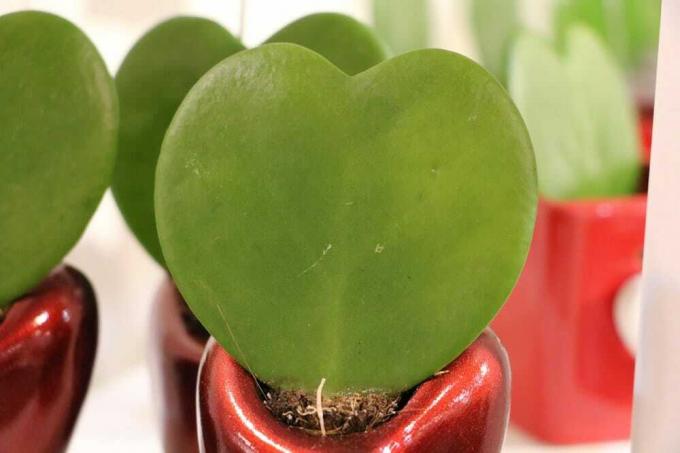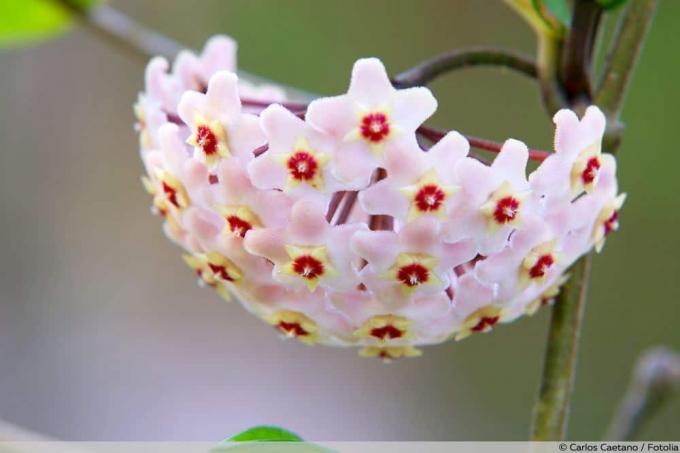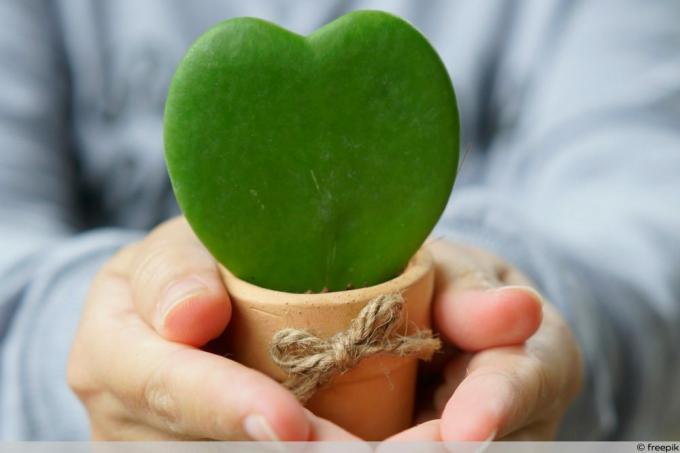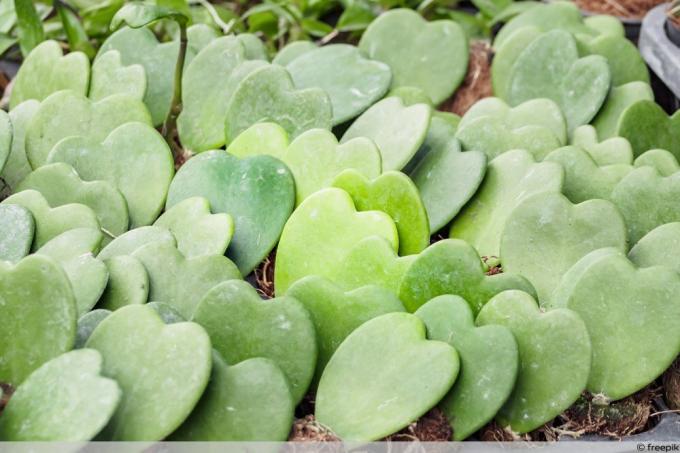
table of contents
- Characteristics
- Care from A - Z
- floor
- Fertilize
- to water
- Toxicity
- plants
- Pests
- Cut
- Location
- Overwinter
- Repot
- Multiply
- Likelihood of confusion
Profile and care information open +conclude -
- Flower color
- red, white, brown
- Location
- Shade, partial shade, no sunshine
- Heyday
- March, April, May, June, July
- Growth habit
- Overhanging
- height
- up to 100 cm high
- Soil type
- sandy, loamy
- Soil moisture
- moderately moist, fresh
- PH value
- neutral
- Limescale tolerance
- Calcium intolerant
- humus
- rich in humus
- Poisonous
- Yes
- Plant families
- Dog poison family, Apocynaceae
- Plant species
- Indoor plants, ornamental plants, container plants
- Garden style
- Conservatory, pot garden
The heart leaf plant can be found in nurseries and flower shops, especially in February for Valentine's Day. However, this is usually only a single, thick-fleshed leaf that was planted as a cutting in the earth. Hoya kerrii is actually much larger and is a popular flowering house plant in the local latitudes. But since it is slightly poisonous, there should be no small children or free-range or free-flying pets in the household.
Characteristics
- Family: silk plants and dog poison plants
- other names: wax flower, porcelain flower
- Growth: up to one meter high, climbing plant
- Growth characteristics: tall with climbing aid, otherwise overhanging
- Location: partial shade to shade, avoid direct sun
- Flowers: leaves white and star-shaped, corolla leaves brown to dark red
- Umbels: up to 25 flowers
- Flowering period: between March and July
- Leaves: deep green and fleshy
- Use: cultivation in a tub, houseplant
- Substrate: loamy and sandy, slightly moist and fresh
- pH value: neutral
- Compatible with lime: no, sensitive to lime
- Nutrients: little if the soil is rich in humus
- Winter hardy: no, sensitive to frost
- Toxicity: Slightly toxic to humans, dogs, cats and free-flying and free-running animals
Care from A - Z

If the Hoya Kerrii receives the right care, it will thank you with lush green leaves and beautiful flower umbels. The heart leaf plant is quite easy to care for if the following points are observed.
floor
The heart leaf plant wants loose, permeable soil in order to thrive. So potting soil can be filled with sand. The permeable, sandy cactus soil is also recommended for the Hoya kerrii. Waterlogging should be avoided, even if the soil should always be slightly damp. Since the wax flower also forms aerial roots, the following substrate is also recommended:
- Enrich potting soil with coconut fibers
- Use orchid soil
- pure potting soil is too dense and firm
- Hydroponics is very suitable
Fertilize
The plants cultivated in pots need fertilizer, as the nutrients are washed out with the irrigation water over time. Here it is sufficient to use liquid fertilizer from the trade, which is given every two to three weeks with the water.
to water
Even if the soil should always be kept slightly moist, waterlogging must be avoided at all costs. In the case of the Hoya kerrii, the soil may well become completely dry between the irrigation processes. Since the heart leaf plant does not tolerate lime, the irrigation water must be low in lime. Collected rainwater is ideal here. If you have no way of collecting rainwater, you can also use stale or, better still, filtered tap water. Above all, high humidity is important, as the thick-fleshed leaves absorb a lot of water from the air. This can be achieved as follows:
- Spray several times a day with low-lime water
- place a bowl of water next to the plant
- use an electric humidifier
Toxicity
Unfortunately, the wax flower is slightly poisonous. For small children in the household as well as dogs and cats in particular, a situation can therefore arise that could be dangerous. Because especially the thick-fleshed, green leaves invite you to nibble on. This is often the case with small children in a playful way. You use the leaves to prepare a salad, for example. In any case, dogs and cats are known to like to nibble on one or the other plant. For this reason, it is advisable not to cultivate the plant if there are small children or pets in the household. If this cannot be avoided, the plant should be placed in such a way that it cannot be reached. If parts of plants have been swallowed, symptoms can be as follows:
- Leaves contain toxin
- especially the escaping juice / milk
- Flower umbels also contain toxin
- two to four drops are not dangerous
- gastrointestinal complaints still occur
- sensitive people react by vomiting
- diarrhea
- Symptoms do not occur simply by touch
So the heart leaf plant is actually not dangerous for humans and animals. If you still want to call the emergency number when one or more symptoms occur in small children, you should do so; the veterinarian can be consulted for affected pets. Calling the poison control center can also help alleviate concerns.
plants

When the Hoya kerrii moves into the household, it is usually already planted in a pot. But this is not suitable for longer, as the substrate is usually not ideal for the plant to stay longer in it. For the individual leaves in the pot, which are usually sold in February, you should proceed as described under the heading "Propagate". An already finished plant is planted as follows:
- choose a sufficiently large bucket
- Prepare the substrate
- Place drainage over the drainage hole
- helps against waterlogging
- Fill in gravel or potsherds
- place plant fleece over this
- Fill in part of the earth
- Insert the plant
- Fill in the rest of the soil
- Pay attention to aerial roots, leave outside the earth
If the plant has been planted, the first thing to do is to water it well so that the entire substrate is moist. After half an hour, it is advisable to pour off the collecting plate so that no waterlogging can develop from here.
Pests
The Hoya kerrii is usually insensitive to pests. However, aphids, scale insects and spider mites can be infested. In summer, when the plant is outside, there will be no infestation. However, in winter, the wax flower should be checked regularly. If a pest infestation has occurred, you should proceed as follows:
- Wash off lice infestations or spider mites
- use pure soapy water for this
- possibly spray off in the shower
- must be repeated several times
- use insecticides in case of severe infestation
- Wear a face mask when spraying
- better to spray outdoors
Cut
The heart leaf plant should not be cut. If it gets bigger, it should only be offered a climbing aid. The flower umbels should also not be removed after blooming, as new buds will form here again. Therefore it is not necessary to cut the plant.
Location
Finding the right place for the heart leaf plant is not that easy. Because it makes many demands. Due to its height, it requires a lot of space upwards. If the plant is simply to hang, it needs a lot of space below. The leaves cannot stand direct sunlight, they burn. Therefore, the location should be very bright, but without direct sun. So the following locations are recommended as follows:
- on the terrace or balcony in summer
- East or west side ideal
- on a shelf or a bright corner in winter
- on an east or west window
- Protect from direct sun with a roller blind
- if the wall behind the plant is white, it is lighter
- the light is reflected back onto the plant
- Avoid drafts
- in winter not directly above or next to a heater
- ideal room temperature between 18 ° Celsius and 25 ° Celsius
Since the heart leaf plant wants high humidity, a place in a bright bathroom is also suitable for the climbing or hanging plant. In winter, temperatures between 10 ° Celsius and 15 ° Celsius are suitable.
Overwinter

In the local latitudes, the heart leaf plant should not be used directly in the garden bed due to its origin, but rather cultivated in a tub. So she can always move to the ideal location. Here the plant is only offered as a houseplant in specialist shops. But in summer it can also move to a sheltered place outdoors. However, frosty nights up to May and from October should be avoided here. The Hoya kerrii therefore do not have proper wintering, but a somewhat cooler location of up to 15 ° Celsius is desired. The following must be observed in winter:
- place bright and cool
- a cool stairwell is ideal
- a bright bedroom
- a cool bathroom
- ensure that the soil is sufficiently moist
- Do not fertilize any more from autumn
- do not start fertilizing again until February
- put it warmer again
- this is how the flower umbels can develop
Repot
The Hoya kerrii only needs to be repotted when the bucket has become too narrow. The ideal time for this after winter is March at the latest. The new bucket shouldn't be too big. One pot size more is sufficient here. The plant is carefully removed from the old container and reinserted in the new one as described under plants.
Multiply
The wax flower can easily be propagated by cuttings. This is the same procedure that flower shops use around Valentine's Day in February to sell hearts in flower pots. So the Hoya kerrii is quickly propagated as follows:
- cut off a sheet
- Use a sharp and disinfected knife
- Put the leaf with the interface in the ground
- to do this, mix sand and peat and keep slightly moist
- place in a bright place without direct sunlight
- Roots form after a short time
- then transplant into a suitable pot
Likelihood of confusion
There is another plant that is also called the heart leaf. However, this belongs to the genus of ivy and is therefore also called ivy tute. The Latin name here is Scindapsus pictus. This type of plant is far more poisonous and therefore more dangerous for humans and animals. But it looks completely different and, unlike the Hoya kerrii, has thin, green leaves with a yellow grain. But since the names are the same, it could easily be confused.



